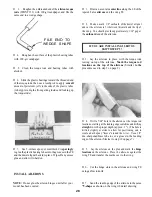
CAUTION (THIS APPLIES TO ALL R/C AIR-
PLANES): If, while flying, you notice any unusual
sounds, such as a low-pitched "buzz", this may be an
indication of control surface "flutter". Because
flutter can quickly destroy components of your air-
plane, any time you detect flutter you must immedi-
ately cut the throttle and land the airplane! Check all
servo grommets for deterioration (this will indicate
which surface fluttered), and make sure all pushrod
linkages arc slop-free. If it fluttered once, it will
probably flutter again under similar circumstances
unless you can eliminate the slop or flexing in the
linkages. Here are some tilings which can result in
flutter: Excessive hinge gap; Not mounting control
horns solidly; Sloppy fit of clevis pin in horn; Elas-
ticity present in flexible plastic pushrods; Side-play
of pushrod in guide tube caused by tight bends;
Sloppy fit of Z-bend in servo arm; Insufficient glue
used when gluing in the elevator joiner wire or
aileron torque rod; Excessive flexing of aileron,
caused by using too soft balsa aileron; Excessive
"play" or "backlash" in servo gears; and Insecure
servo mounting.
2-VIEW DRAWINGS
USE THIS FOR PLANNING YOUR TRIM SCHEME
LANDING: When it's time to land, fly a normal
landing pattern and approach. You will find that the FUN-
ONE will slow up very well and land very nicely and
predictably. If your FUN-ONE is built straight and true,
you'll find that you can really flare it out for slow, nose-
high, full-stall landings without fear of tip stalling.
Have a ball! But always stay in control and fly in a
safe manner.
GOOD LUCK AND GREAT FLYING!
SEE THE FULL LINE OF GREAT PLANES
AIRPLANES AT YOUR HOBBY DEALER.
WE HOPE YOU WILL SELECT ANOTHER
"GREAT PLANE" AS YOUR NEXT PROJECT.
THANK YOU!
39
Summary of Contents for FUN-ONE
Page 5: ...5...


































